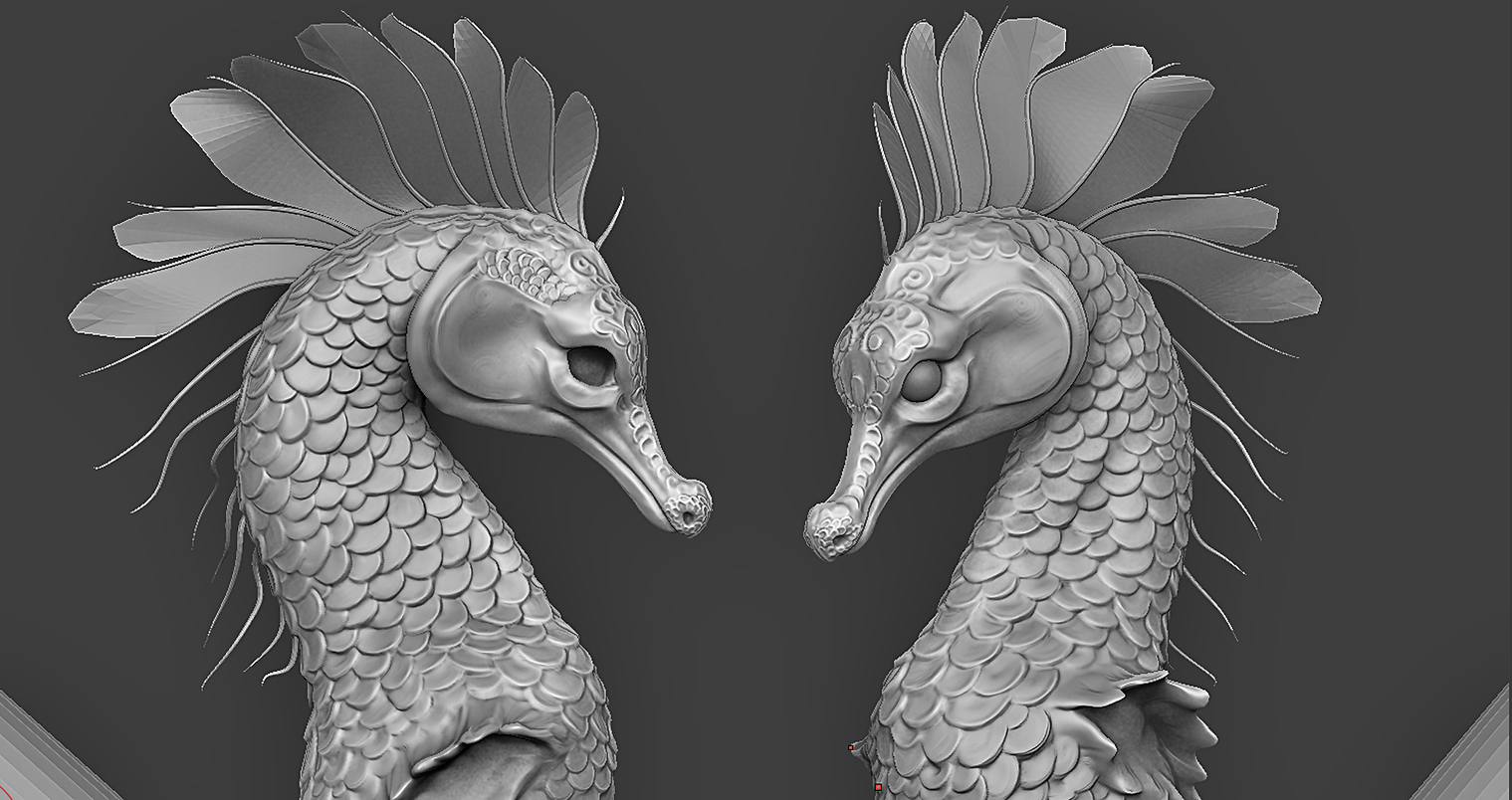I learned that fins are a lot of work. Sculpting scales, no problem. Making fins? ehhhhh.
In this update, I changed the face a bit and continued blocking out the scales on the body .
I decided that I really didn't like the fins on the seahorse from week one , so I decided that I wanted to begin to play around with shapes and ideas that I'd be happier with. Since this guys isn't really grounded in reality, I took a lot of liberties with how big the fins were and how they were shaped. In the end, I decided to go with a spiny dorsal look , like a bass but much longer in comparison to the body like a lion fish. I played around with shape and flow as well, drawing influence from beta fish. I think this gave me some really nice, elongated and smooth shapes to play with.
To do this, I used the Curve tool to give me a nice flow and action line.
When I was happy with the overall shapes, I lofted the curve to create a large dorsal fin shape. Using the new surface of the loft, I generated multiple "spine curves" . When I was happy with their flow, I placed and extruded cylinders along them, making sure to taper the fall-off so that the spices come to a fine point.
Finally, I wanted to generate individual, slightly attached fins between each spine. To do this, I extracted a curve from the inner and outer edges of each spine cylinder and then lofted them together with an additional curve between them, to drive the roundness of the fin tip.
When I was happy with the curves, I converted them to polygons and tested an import into Zbrush.
Making the fins is time consuming but I am happy with the general layout and quality of them. I will continue building them out along the back of the seahorse and on the sides. Once I finish the general fin shapes, I will add detail to them and smooth them out in Z- Brush. In the meantime, I will get plenty of practice with nurbs modeling and poly conversions!
<< WIP : Elegant Seahorse Part I || WIP : Elegant Seahorse III >>
I decided that I really didn't like the fins on the seahorse from week one , so I decided that I wanted to begin to play around with shapes and ideas that I'd be happier with. Since this guys isn't really grounded in reality, I took a lot of liberties with how big the fins were and how they were shaped. In the end, I decided to go with a spiny dorsal look , like a bass but much longer in comparison to the body like a lion fish. I played around with shape and flow as well, drawing influence from beta fish. I think this gave me some really nice, elongated and smooth shapes to play with.
 |
 |
 |
Working on Fins
To create the fins, I exported my seahorse into Maya and decided to get an overall feel for flow and shape with the dorsal fins.To do this, I used the Curve tool to give me a nice flow and action line.
 |
| First, I used curves to give me an idea of the size and overall shape of the fine masses. I planned on making each spine of the dorsal fin separate, similar to a lion fish. |
When I was happy with the overall shapes, I lofted the curve to create a large dorsal fin shape. Using the new surface of the loft, I generated multiple "spine curves" . When I was happy with their flow, I placed and extruded cylinders along them, making sure to taper the fall-off so that the spices come to a fine point.
 |
| I lofted the general shapes of the dorsal fins to get an idea of the flow and to generate spine curve shapes. Once I did this, I extruded cylinders along the spine curves with a bit of a taper. |
Finally, I wanted to generate individual, slightly attached fins between each spine. To do this, I extracted a curve from the inner and outer edges of each spine cylinder and then lofted them together with an additional curve between them, to drive the roundness of the fin tip.
When I was happy with the curves, I converted them to polygons and tested an import into Zbrush.
Making the fins is time consuming but I am happy with the general layout and quality of them. I will continue building them out along the back of the seahorse and on the sides. Once I finish the general fin shapes, I will add detail to them and smooth them out in Z- Brush. In the meantime, I will get plenty of practice with nurbs modeling and poly conversions!

Comments
Post a Comment